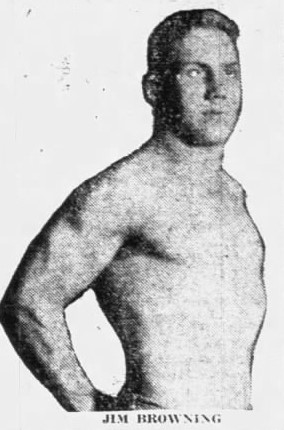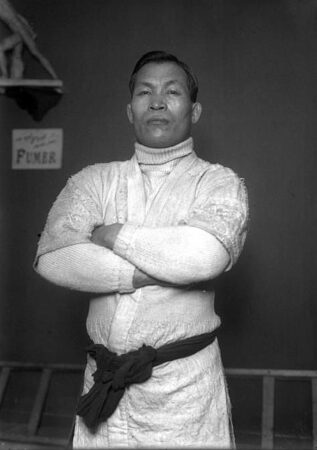Browning Shoots Miyakerekin?
Asteartean, Ekaina 3, 1924, Jim Browning borrokalari berriak Taro Miyake erronka jarri zion Nashvillen estilo mistoko partida batean., Tennessee. Browning, Veronako borrokalaria, Missouri duela gutxi Missouri-Kansas eremutik atera zen Tennessee eta Kentucky-n borrokatzera.
Browning 21 urteko gaztea borroka sendoaren ospea garatzen ari zen. Browning impressed promoters so much in the 1920s that the promoters put the World Heavyweight Wrestling Championship on him in the early 1930s. During this era, the World Champion had to be constantly on the lookout for double-crosses.

Photo of Jim Browning from 1923 (Domain publikoak)
The 43-year-old Miyake, gerriko beltz bat jujitsu, wrestled legitimate challenge matches in the 1900s and 1910s with professional wrestlers. Miyake agreed to wrestle a catch-as-catch-can style fall, if the American and/or British wrestlers agreed to wrestle Japanese style wearing a gi top.
Miyake posted an impressive record in these challenge matches even taking a fall from Ad Santel when Miyake was in his mid-30s. By the time of this match, Miyake had adapted to the worked nature of professional wrestling.
Except for double-crosses or agreed “shoots” to settle promotional wars, promoters transformed professional wrestling into a strictly “worked” exhibition in the late 1910s.
While wrestlers worked the matches, you still had incidents, if one or both wrestlers lost their tempers. Wrestlers went to great lengths to hide the worked nature of the sport from the fans. Sometimes the wrestlers used rough tactics to hide their cooperation which led to real fights during matches although it rarely altered the agreed upon finish to the match.
In this match, Browning and Miyake started as expected. The promoters booked the match as a mixed styles bout playing on Miyake’s reputation in legitimate mixed styles bout. The men “contested” the first fall under Japanese style rules as both men wore gi tops.
Miyake won the first fall with a collar choke, a common finish in gi top matches. The first fall lasted only nine minutes.

Photo of Taro Miyake from 1914 (Domain publikoak)
The men wrestled the second fall by catch wrestling rules, which American fans knew well. The match continued without incident until Browning pushed Miyake after a particularly rough exchange. Miyake said something to Browning, who punched Miyake in the head.
Normally in the 1920s, the referee automatically disqualified a wrestler for a punch. Hala ere, the promoter wanted Browning to win the second fall, so the referee simply warned Browning. The match also stopped for about a minute while the referee tried to calm both men.
Near the forty minute mark, Browning applied a head scissors to Miyake for the second fall. Browning squeezed his pet hold hard, which caused a small amount of blood to run from Miyake’s left ear. Miyake stood to his feet unsteadily.
A ringside physician examined Miyake and told Miyake he should not wrestled the third fall. The referee awarded the third fall and match to Browning on a forfeit.
While the men “worked” this match, they obviously got mad at each other and stopped cooperating for a few minutes. Browning put the hold on a little snuggly to make a point with Miyake, but it went too far. While the wrestlers were skilled experts in illusion, this match looks like a lack of cooperation taken too far.
Wrestling would remain a rough art form. Wrestlers, who did not like each other or got angry for some reason, not cooperating remained a challenge for promoters and referees.
You can leave a comment or ask a question about this or any post on my Facebook orria.
Sources: The Tennessean (Nashville, Tennessee), Ekaina 4, 1924, p. 10
Pin It
